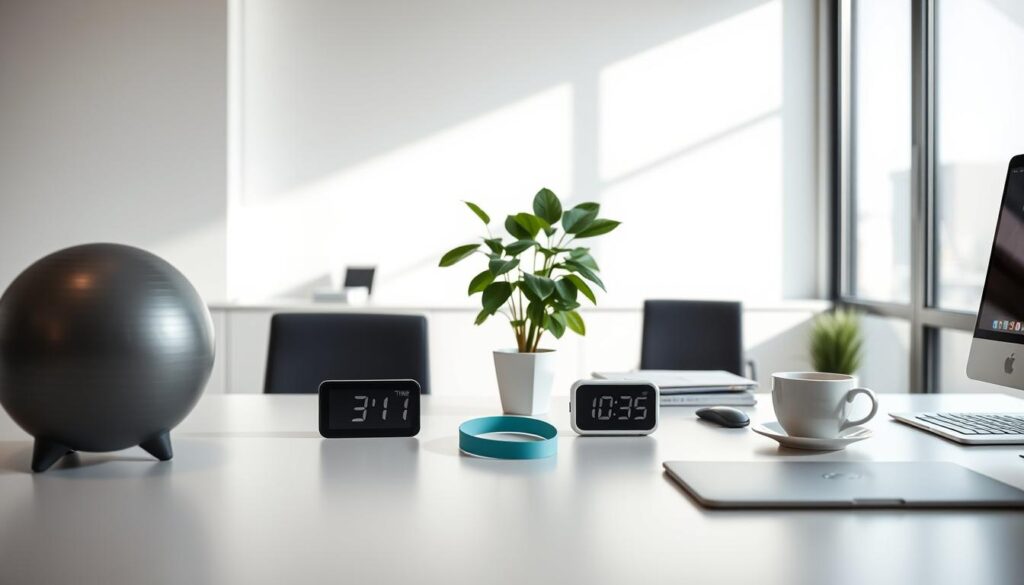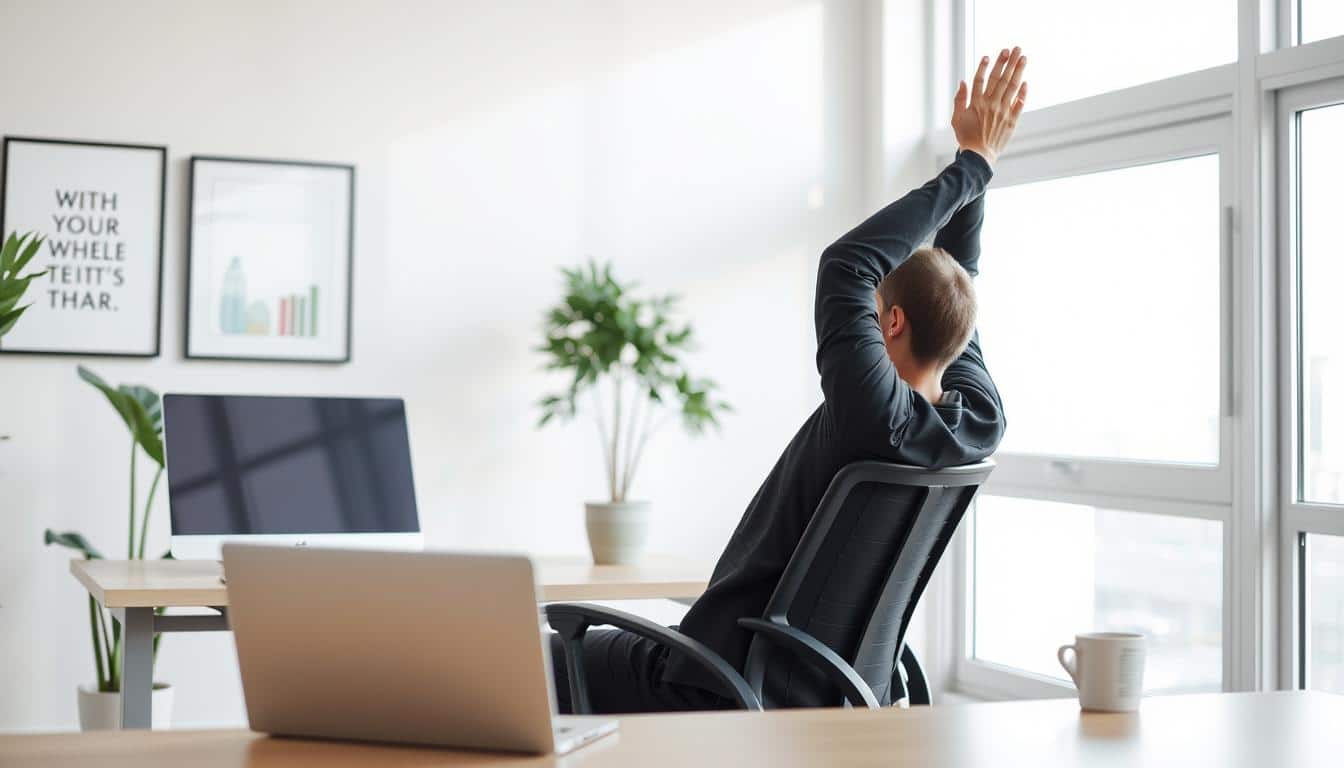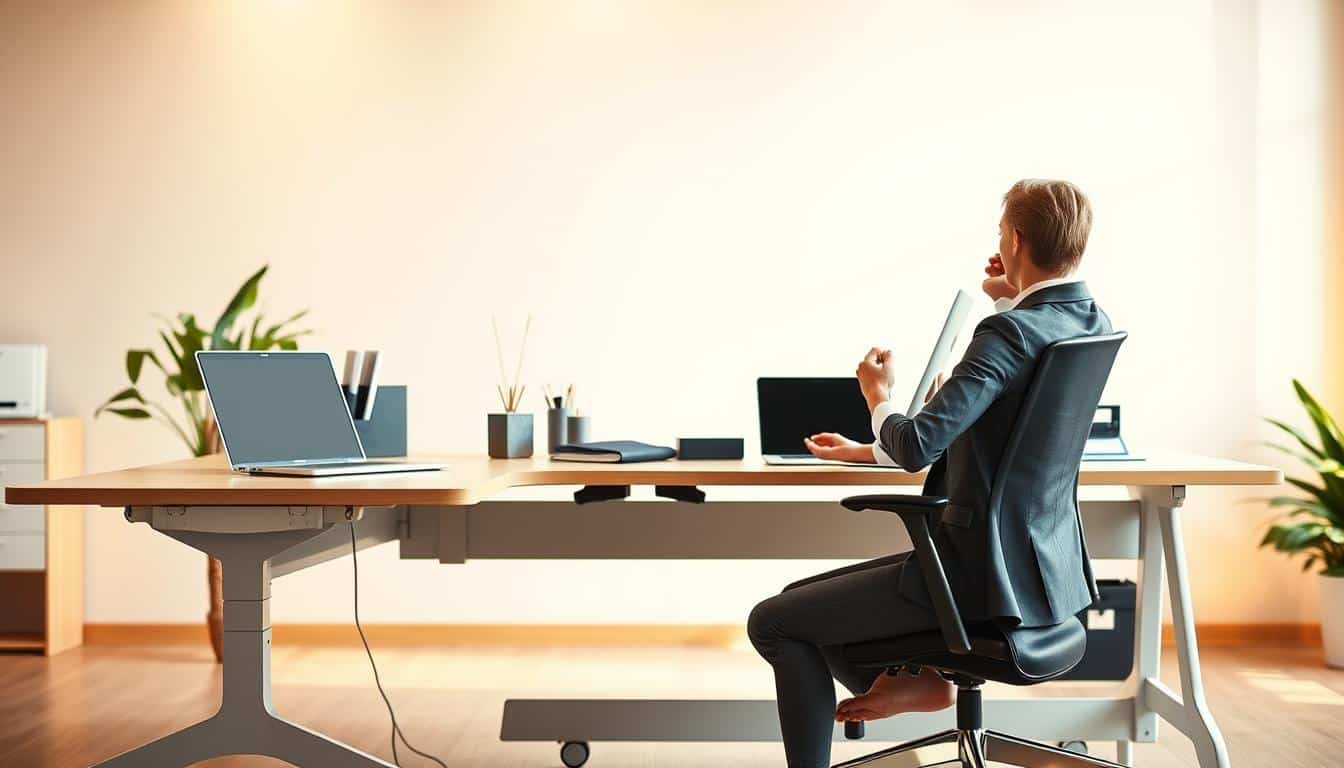In our busy work life, sitting too much is common, especially at desk jobs. Sitting too long can really cut down on our body’s ability to burn fat by up to 90% within just an hour. That’s why it’s key to keep moving at work.
Adding easy sitting exercises to your day can make a big difference in how you feel. Exercises like neck rolls and leg stretches can ease pain, help you sit better, and make you more focused. Keep reading to find out how to stay active at the office.
The Importance of Staying Active at Your Desk
Today, many of us work in jobs where we sit a lot. This can be bad for our health and happiness. To keep healthy, it’s important to move around and take breaks during work.
Understanding the Impact of Sedentary Lifestyles
Sitting too much can lead to health problems. Studies have linked long sitting times with obesity, heart disease, and diabetes. Moving more at work can help blood flow better. It can also lessen the bad effects of sitting too much. Small changes, like lifting weights or short walks, can make a big difference in how fit and sharp we feel.
Common Health Issues Linked to Prolonged Sitting
Working at a desk can cause neck and back pain, and make us feel more stressed. Taking active breaks helps fight these problems. Doing simple exercises at your desk can help a lot. Also, following set programs for strength and balance can help us stay healthy while we work.
Simple Sitting Exercises to Boost Your Mood
Adding quick exercises to your workday can make you feel much better mentally. You can do simple activities like desk push-ups, triceps dips, and seated leg raises without needing much room. Doing these for just a short time can raise your energy and help you beat the midday low.
Desk Push-Ups
Desk push-ups are great for making your upper body stronger, especially your arms and back. Just put your hands on the edge of your desk and step back a bit. Then lower yourself towards the desk and push yourself back up. Try to do 10-15 reps to get your blood moving and lessen tension during the day.
Seated Leg Extensions
Seated leg raises are beneficial, too. Sit straight, extend one leg until it’s in line with the floor, then bring it down. Do this 10-15 times for each leg. It works out your quads and hamstrings and boosts your blood flow.
Triceps Dips
To strengthen your arms while sitting, try triceps dips. Sit on the edge of your chair and lower your body by bending your elbows, then push back up. This exercise is good for your upper arms and also helps your mental health.
Top Sitting Exercises to Improve Focus and Energy
Being active at your desk boosts focus and energy. Doing exercises helps with core strength and keeps your mind sharp. Here are some great sitting exercises to energize your workday.
Desk Planks for Core Strength
Desk planks strengthen your core. Put your forearms on the desk, step back until your body is straight, and hold for 20-30 seconds. This not only builds core strength but also helps you stay focused all day.
Chair Side Planks
Chair side planks work on the obliques and core. Lean to one side and use one hand for support. Hold for 20-30 seconds to feel the stretch. It’s perfect for a quick focus boost during work.
Seated Knee-to-Chest Exercise
This exercise eases tension and improves blood flow. Sit on the edge of your chair, bring one knee to your chest, and hold. Switch legs. It’s good for your core and helps you focus on your tasks.
Effective Sitting Exercises for Desk Jobs
Adding simple exercises to your desk job can make a big difference. These steps can enhance your core strength and your overall health. Not only can they improve your posture, but they’re easy to do during your workday without any special gear.
Oblique Twists for Core Engagement
Oblique twists are great for strengthening your core while sitting. Just sit up tall and turn your upper body to one side. Keep this position for a few seconds before turning to the other side. This move not only works your core muscles, but it also makes your spine more flexible.
Seated Flutter Kicks to Strengthen Legs
Seated flutter kicks are perfect for building leg strength. While sitting, stretch your legs out and kick them gently up and down. This not only shapes your legs but also boosts blood flow. It’s especially good for people who sit a lot.
Glute Squeezes for Improved Posture
Squeezing your glutes helps your posture, even when you’re sitting. Just tighten your glute muscles for a few seconds and then relax. This exercise makes your back and pelvis muscles stronger. It helps keep your body aligned and lessens pain.
Incorporating Stretching into Your Workday
Stretching is key for staying well at your desk. It gives back relief and makes your torso more flexible. This reduces the discomfort from sitting too long. You can easily add simple stretches to your workday. They help you feel refreshed and relaxed.
Forward Stretch to Relieve Back Tension
The forward stretch helps ease back pain from sitting too much. Sit up straight, lean forward, and reach towards your feet or the floor. Stay like this for a few seconds and breathe deeply. This stretch makes your spine flexible and eases lower back strain.
Torso Stretch for Better Flexibility
For more flexible torso, try the torso rotation stretch. While sitting, put one hand on your chair’s back and twist your body to the side. Hold it for some breaths then switch sides. It loosens your back and improves your core’s mobility. Your posture will get better and feel more comfortable.
Standing Exercises for a Quick Break
Doing standing exercises during office breaks can make your workday better. Stand up and move like walking around or using an adjustable desk. It helps improve health. Simple moves like calf raises and squats are good for posture and keeping energy up.
Walking Around the Office
Walking around the office can do a lot of good. It gets your blood flowing and clears your mind. This can make you more creative and focused. Try to take short walks every hour to stay active.
Using an Adjustable Desk
An adjustable desk lets you stand while you work. Standing and sitting alternately is good for your posture and muscles. Use your adjustable desk to do some standing exercises and boost your energy.
Calf Raises and Squats
Doing calf raises makes your calves and buttocks stronger. Just stand up straight, lift your heels, and hold. Squats work on your legs and core. Try to stay in a squat as long as you can for a real challenge.
Adding standing exercises to your break times is great for a healthier office life. These small actions can make big positive changes in how you feel every day.
Creating Effective 5-Minute Workouts
For many of us with busy schedules, finding time to exercise can be tough. That’s where five-minute workouts come in. These quick sessions are perfect for staying active without taking up too much of your day. By focusing on specific groups of muscles, you can improve your flexibility and overall health.
Targeting Muscle Groups Efficiently
When you only have five minutes, it’s important to hit different muscles. Here are some exercises to try:
- Cat cow for spinal flexibility
- Alternating Spiderman lunges for leg strength
- Lying 2-way Superman for back muscles
- Glute bridge for glute strength
Use a pattern of 40 seconds of work followed by 20 seconds of rest. This approach makes the most of your time and brings great results.
Combining Exercises for Quick Sessions
You can add these quick exercises to your five-minute workout:
- Neck rotations to ease tension
- Back twists for better spinal movement
- Shoulder pinches for a straighter back
- Leg extensions to strengthen your lower body
- Chair squats for a strong core
- Desk push-ups for arms and chest
Doing these short workouts more than once a day can help keep your fitness on track. They’re perfect for increasing blood flow and fighting the bad effects of sitting too long. This boosts your health significantly.
Benefits of Regular Desk Exercises
Regular desk exercises help both your mind and body. They lower stress and make you more productive. Small movement breaks during work improve mental health. They make you feel better and less anxious. This makes for a better place to work.
Reducing Stress and Anxiety
Doing exercises at your desk can cut down on stress and nervous feelings. Moving a little releases endorphins, making you happier. Adding these exercises into your day can lead to:
- Lower stress levels
- Improved mental wellness
- Enhanced creativity
- Less body pain from sitting too much
Also, stepping away for exercise every couple of hours is good for both body and mind.
Enhancing Overall Productivity
Desk exercises can make you work better. People who do little workouts throughout the day do their jobs more effectively. Benefits include:
- Better focus and concentration
- More energy
- Faster task completion
Try doing strengthening exercises, twists, and squats at your desk to fight tiredness. The CDC suggests 150 minutes of exercise a week for health.
How to Stay Consistent with Your Desk Exercises
Working out during office hours can make you feel better overall. It’s good to set reminders for moving around and to have someone who keeps you on track. These steps help you stay active without losing focus on your work. Let’s look at how to keep up a regular exercise routine.
Setting Reminders for Movement
Reminders are key to remembering to get up and move. You can use apps or timers to help schedule your work and include short exercise breaks. Here are some tips:
- Set a timer for 30-60 minutes to take a quick 2-3 minute break for movement.
- Incorporate simple exercises like squats, stretches, and seated twists during these breaks.
- Use the Pomodoro technique to balance work and breaks efficiently.
Structuring your day to include exercise can prevent you from feeling stiff. It also helps you work better and have more energy.
Finding an Accountability Partner
Having someone to exercise with makes you more likely to stick with it. Working out with a coworker can create a supportive atmosphere. Here’s how to do it:
- Set shared health goals, such as enhancing mobility or weight management.
- Engaging in team activities, like group yoga or planned fitness classes during breaks.
- Tracking progress together to celebrate achievements and adjust goals as needed.
Encouraging each other makes it easier to keep exercising. This way, daily physical activity becomes a normal part of your day at work.

Conclusion
Making simple sitting exercises part of your day can bring big health and productivity boosts. This is especially good for people with desk jobs. Adding office fitness can greatly cut down sitting risks. Even little actions, like walking five minutes every half hour, can really drop blood sugar levels by 58%. Plus, it can lower blood pressure by 4 to 5 mmHg.
Using these techniques improves health and makes work life better. Sitting exercises can make you happier and less tired. This helps you stay active all day. A study in the British Journal of Sports Medicine shows that 30-40 minutes of daily exercise is key to fight off the bad parts of sitting too much.
Putting these small movements into your day makes for a healthier workplace. Everyone gets more done and stays focused. Doing sitting exercises is crucial for lessening heart disease risk and keeping you healthy for a long time. Make a move to a more energetic work style and see the benefits it offers.



